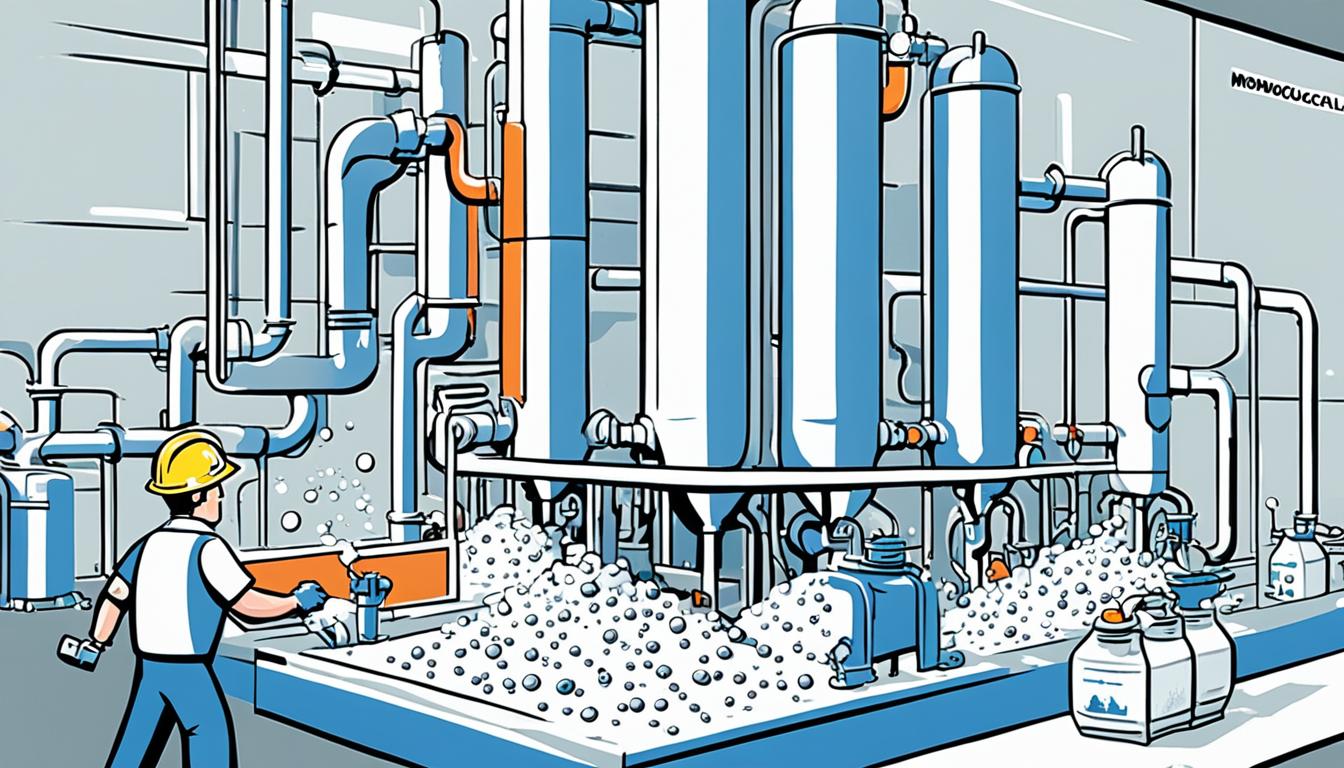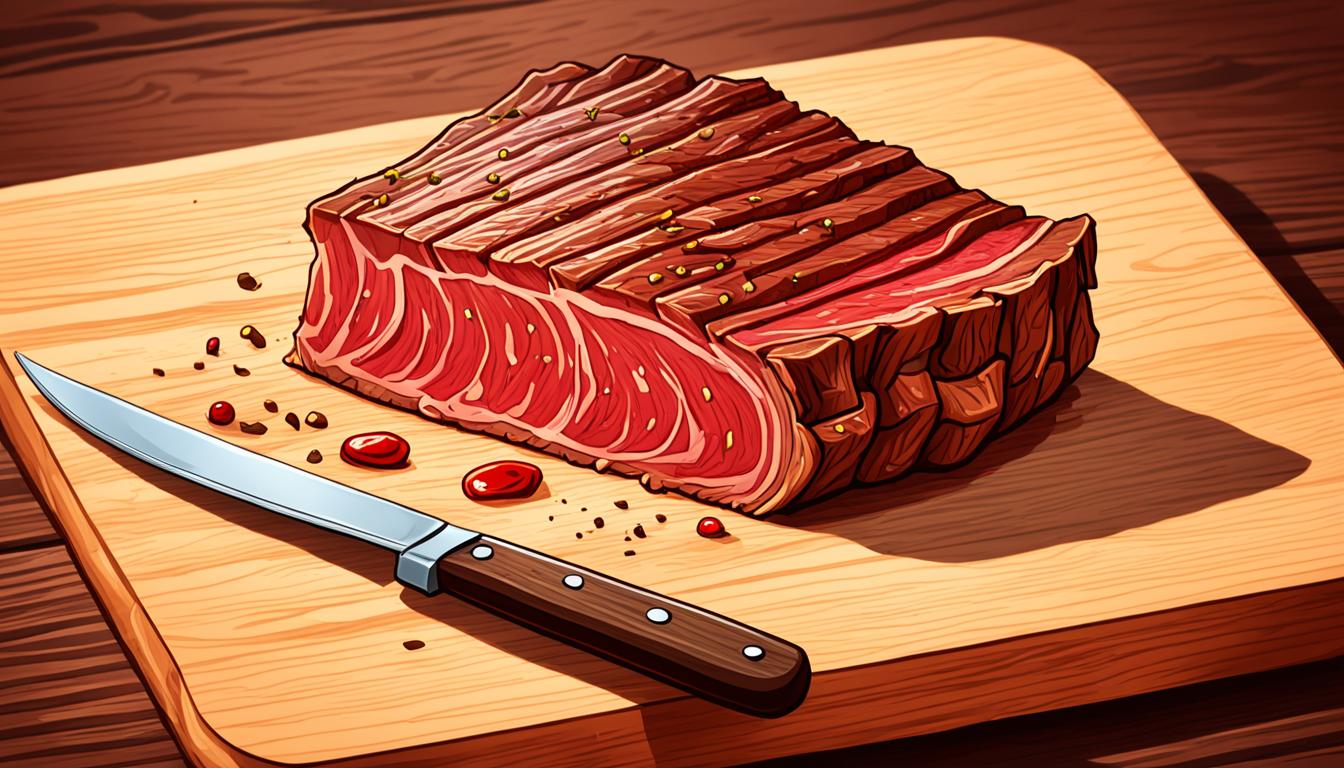Monocalcium phosphate is a key ingredient in many industries. This includes food, baking, and even animal feed. It comes from mixing calcium hydroxide with phosphoric acid. This guide will cover what monocalcium phosphate is, its uses, and its benefits.
Key Takeaways:
- Monocalcium phosphate is a versatile compound used in industries such as food, baking, agriculture, and animal feed.
- It is derived from a reaction between calcium hydroxide and phosphoric acid.
- Monocalcium phosphate offers numerous benefits, including improving texture and flavor in food, supporting plant growth, and providing essential nutrients.
- Safety and proper handling procedures should be followed when working with monocalcium phosphate.
- Consulting with a healthcare provider is important before starting any new supplement regimen.
Understanding Monocalcium Phosphate Production
Monocalcium phosphate is widely used in many sectors. Its making involves mixing calcium hydroxide with phosphoric acid. This results in a refined product that’s then dried and made into a powder for different uses.
Making monocalcium phosphate demands careful control and following safety rules. Modern technology ensures the process is efficient and eco-friendly. Efforts are made to produce it responsibly.
The first step to make monocalcium phosphate is to mix calcium hydroxide with phosphoric acid. This mix forms monocalcium phosphate. It’s then cleaned and refined in several ways.
Manufacturing monocalcium phosphate is key for food, farming, and animal feed sectors. High-quality standards are critical to ensure the product is effective and safe.
After cleaning, the monocalcium phosphate is dried. This step removes moisture. It makes sure the compound is stable and useful for various applications.
The last step is to grind the dried compound into powder. This powder blends easily into products. It doesn’t change their texture or how they feel.
Benefits of Advanced Technologies
Advanced technologies improve monocalcium phosphate making. They help control the chemical reaction to get a pure and high-quality product.
Using sustainable methods reduces the environmental footprint. It means manufacturing that doesn’t harm the planet. Plus, it leads to a greener future.
These technologies also make production more efficient. They cut down costs. This helps meet the high demand for monocalcium phosphate.
| Advantages of Advanced Technologies in Monocalcium Phosphate Production |
|---|
| Enhanced purity and quality of the final product |
| Reduced environmental impact through sustainable practices |
| Improved efficiency and cost-effectiveness |
Thanks to technology and a focus on eco-friendly methods, monocalcium phosphate production is advancing. This ensures its continued availability for various industries.
The Role of Monocalcium Phosphate in Baking
Baking is an art that needs exact measurements and specific ingredients. One crucial ingredient is monocalcium phosphate. It acts as a leavening agent, helping to make baked goods light and fluffy. This ensures a great texture and taste.
When you mix monocalcium phosphate with baking soda and liquid, a magical reaction happens. This reaction forms carbon dioxide gas, which makes the dough rise. As the gas expands in the oven, it creates air pockets. Thus, your baking ends up perfectly risen, light, and airy. It’s a joy to eat.
Monocalcium phosphate is widely used in commercial baking powders, which are the secret behind the consistent quality of various baked products.
Let’s dive deeper into the impact of monocalcium phosphate in baking:
Efficient Leavening Properties
- As a leavening agent, monocalcium phosphate reacts quickly and evenly. This ensures the carbon dioxide gas spreads well through the dough or batter.
- Its quick action is crucial for products that need immediate baking. This prevents the dough from collapsing too soon.
Improved Texture and Shelf Life
- Monocalcium phosphate makes baked goods light, soft, and tender.
- It also creates a fine crumb structure, making the products look better.
- Plus, monocalcium phosphate helps keep baked goods fresh longer, preserving their quality.
Flexible Applications
- This ingredient can be used in cakes, bread, muffins, cookies, and more.
- It works well with other baking ingredients, making recipes more flexible.
Monocalcium phosphate’s leavening properties make every bite of baked treats perfect. Next time you enjoy a fluffy cake or a chewy cookie, remember to appreciate this amazing ingredient. It helps bring these tasty creations to life.

Monocalcium Phosphate as a Food Additive
Monocalcium phosphate is a key food additive that enhances the texture and flavor of many foods. It is used in several products like baked goods, cheese, and canned fruits and vegetables.
This additive helps make baked items softer and more moist. It also helps dough to rise, giving bread and pastries a light, fluffy feel.
Besides improving texture, monocalcium phosphate adds crucial calcium to our diet. Calcium is essential for strong bones and teeth. It also helps muscles and nerves work properly.
Monocalcium phosphate improves food taste and texture. It also boosts our nutrition by adding essential minerals.
It’s important to handle monocalcium phosphate correctly to keep its quality. Store it in a cool, dry spot. Make sure it doesn’t get wet or too hot.
In summary, monocalcium phosphate is a beneficial food additive. It makes foods tastier and textures better. Plus, it gives us important minerals like calcium. Following safety steps ensures we keep getting these benefits.

| Food Products | Benefits |
|---|---|
| Baked goods | Improved texture and moisture retention |
| Cheese | Enhanced flavor and texture |
| Canned fruits and vegetables | Prolonged shelf life and retention of nutrients |
Benefits of Monocalcium Phosphate as a Supplement
Monocalcium phosphate supplements can be very healthy. They are a good source of calcium. This helps keep bones strong and lowers the chance of osteoporosis.
These supplements also help with high blood pressure and type 2 diabetes. Calcium is key for controlling blood pressure and helps with insulin use. It’s vital for a healthy diet.
Still, these supplements can’t take the place of eating well. A balanced, nutritious diet is key to staying healthy. Supplements should just fill in the missing pieces of our nutrition.
Talking to a healthcare provider before starting supplements is wise. They can see if monocalcium phosphate is a good choice for you. They will also guide you on how much to take to get the best results.
Benefits of Monocalcium Phosphate Supplements:
- Supports bone health
- Reduces the risk of osteoporosis
- Promotes calcium intake
- Aids in regulating blood pressure
- Assists with insulin sensitivity in individuals with type 2 diabetes
“Monocalcium phosphate supplements are a helpful way to get more calcium. But remember, they should be part of a bigger health plan that includes good food and exercise.”

Consult with a Healthcare Provider
If you’re thinking about monocalcium phosphate supplements, talk to a healthcare provider first. They can help decide if they’re right for you and how to use them safely.
Remember, these supplements aren’t a substitute for healthy eating or medical care. They’re meant to enhance your overall health.
Monocalcium Phosphate in Fertilizers
Fertilizers are key to great plant growth and yields. Monocalcium phosphate is important in making fertilizers. It helps adjust soil pH and feeds plants.
Monocalcium phosphate is water-soluble. This lets plants easily get phosphorus and calcium from it. These nutrients are crucial for roots, flowers, fruit, and cell walls.
For ideal soil pH, monocalcium phosphate is a go-to. Adjusting pH means plants get the best nutrient conditions. This helps them grow well.
But, using monocalcium phosphate fertilizers correctly is crucial. Wrong use can harm soil and water. Good practices let us enjoy its benefits without risks.
Sustainable Agriculture and Monocalcium Phosphate Fertilizers
Sustainability in farming is getting more attention, including how we use fertilizers. Farmers are choosing ways that are good for the earth. Monocalcium phosphate fertilizers fit right into this, offering precise nutrient use.
“Monocalcium phosphate-based fertilizers offer a sustainable solution for farmers seeking to enhance soil fertility and optimize plant nutrition,” says Dr. Jane Peterson, an agricultural expert at GreenEarth Farms. “Their water-solubility and nutrient content make them an effective choice for optimizing crop yields while minimizing environmental impact.”
Using monocalcium phosphate, farmers can better soil and plant health. This leads to greener farming methods.
Enhancing Crop Management with Monocalcium Phosphate
Monocalcium phosphate is great for managing crops too. It releases nutrients slowly. This means plants get a steady diet of phosphorus and calcium.
Its water-solubility means plants use up the nutrients well. This cuts down on waste and extra fertilizer use. It makes for healthier plants.
Together with nitrogen and potassium, monocalcium phosphate makes a complete fertilizer. This tailored approach helps crops grow strong. It fights off common soil and nutrition issues.
Using monocalcium phosphate in fertilizers is smart. It helps with soil, feeding plants, and eco-friendly farming. Its benefits make it a top choice for modern agriculture.

| Benefits of Monocalcium Phosphate in Fertilizers |
|---|
| Provides essential nutrients like phosphorus and calcium for optimal plant growth |
| Water-solubility allows for efficient nutrient absorption by plants |
| Assists in soil pH adjustment, creating an ideal growing environment |
| Reduces the risk of nutrient wastage or leaching |
| Contributes to sustainable agriculture practices by optimizing nutrient utilization |
Monocalcium Phosphate in Animal Feed
Monocalcium phosphate is key in animal feed. It gives animals important nutrients for their health and growth. It is rich in phosphorus which helps with bone growth, turning food into energy, and making DNA.
This ingredient also has a lot of calcium, important for animals too. Calcium helps muscles work, carries signals in nerves, and keeps teeth and bones strong.
Using the right amount of monocalcium phosphate in feed matters a lot. It’s important to stick to recommended amounts. This makes sure animals get good nutrition without health problems from too much phosphorus or calcium.

“Monocalcium phosphate provides essential nutrients for bone development, energy utilization, and DNA synthesis in animals.”
Safety and Handling of Monocalcium Phosphate
It’s crucial to put safety first when using monocalcium phosphate. This substance is a white powder used in many industries. It must be handled carefully to protect workers and lower risk.
Material Safety Data Sheet (MSDS)
Get to know the safety rules in the Material Safety Data Sheet (MSDS) before using monocalcium phosphate. The MSDS shares key details on hazards, handling tips, and what to do in an emergency with this chemical.
“The MSDS is an invaluable resource, offering detailed insights into the safe handling, storage, and disposal of monocalcium phosphate. By consulting the MSDS, you can mitigate risks and ensure a safe working environment for all.”
Adherence to Handling and Storage Procedures
Following the right handling and storage tips is key with monocalcium phosphate. Here are some vital tips:
- Wear proper safety gear like gloves, goggles, and a dust mask to avoid skin and lung irritation.
- Work in a place with good airflow or use a mask to keep from breathing in the powder.
- Always wear protective glasses to keep your eyes safe.
- Don’t eat the compound, as it might upset your stomach.
- Keep it in a cool, dry area away from things like acids or substances that burn easily.
- Make sure containers are well-packed and labeled to avoid accidents.
Training and Education
It’s vital to teach employees about safely handling monocalcium phosphate. They need to learn the correct ways to work with it, respond to emergencies, and use safety gear right.

Summary
Putting safety first and following the right steps can reduce risks when using monocalcium phosphate. Workers should be well-trained to manage this substance carefully. This ensures everyone’s safety at work.
Other Uses of Monocalcium Phosphate
Monocalcium phosphate is known for its role in baking, farming, and animal feed. But its use goes much further. It’s also found in various other areas, helping to improve different industries. This shows how versatile monocalcium phosphate is.
Buffering Agent in the Pharmaceutical Industry
In the world of medicine, monocalcium phosphate acts as an important buffering agent. It keeps the pH in drugs balanced. This ensures they are stable and work well.
Its buffering power also helps the body absorb medications more effectively. This use of monocalcium phosphate underlines its flexibility and importance.
Mineral Supplement in the Cosmetics Industry
In cosmetics, monocalcium phosphate is added as a mineral boost. It has lots of calcium, which nourishes our skin and hair. Beauty products with this ingredient make skin and hair look better and healthier.
This showcases the compound’s effectiveness as a mineral supplement.
“Monocalcium phosphate’s versatility is a testament to its value as a chemical compound, finding purpose in diverse industries.”
Clarifying Agent in the Brewing Industry
In brewing, monocalcium phosphate helps make beer better. It works as a clarifying agent. This means it removes stuff you don’t want in your beer, making it clearer.
This leads to a higher quality drink. Brewers count on it to meet the expectations of their customers. This is yet another proof of the compound’s broad usefulness.
Monocalcium phosphate is valuable in many areas. It’s not just for buffering in medicine or as a supplement in cosmetics. It also clears up brews. These diverse uses highlight its adaptability and innovative potential.

Exploring the many uses of monocalcium phosphate reveals its significant role. It helps improve various processes and products in many fields. Its wide range of uses and benefits makes it key in several industries.
Conclusion
Monocalcium phosphate is a key ingredient used in many areas. It improves food texture and taste in baking. It also adds important nutrients as a food additive. In fertilizers, it helps plants grow and get the right nutrients. For animals, it aids in bone growth and general health.
Working safely with monocalcium phosphate is vital. We must follow handling and safety rules. This prevents risks and allows us to benefit from it while staying safe.
This compound is incredibly important in various fields. It’s essential in baking, food making, farming, and feeding animals. Knowing how to use it and staying safe lets us take advantage of monocalcium phosphate. It ensures the safety of workers and customers alike.










